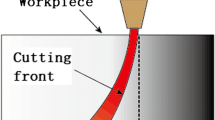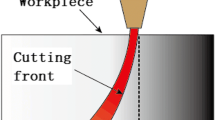Abstract
As the only cold processing technology at present, abrasive water jet (AWJ) has been successfully applied in many industrial fields. However, the tool of the AWJ is a soft knife, which will be deformed during the cutting process, resulting in kerf error, which seriously affects the machining accuracy. At present, the commonly used method to eliminate the kerf error is the taper compensation processing method. However, the contour curve of the kerf is not a straight line in most cases, so that there are still residual errors in the processing of the taper compensation method. In this paper, the residual error is defined as the deviation error, that is, the maximum error of the kerf contour deviating from the taper direction. Based on the experiment of AWJ cutting aluminum alloy 6061-T6, a detailed study is carried out on the influence of processing parameters such as cutting speed, water pressure, abrasive flow rate, and material thickness on the deviation error, and an empirical model of the deviation error is established through data fitting. This will help to better understand the kerf error of AWJ and has important guiding significance for optimizing processing parameters and improving processing accuracy.















Similar content being viewed by others
Data availability
All data is published with the paper.
References
Andrew YCN (2014) Handbook of manufacturing engineering and technology. Springer-Verlag, London, pp 1652–1653
Pierri LC, Santos RPD, Junior JJDP, Pains AM, Noronha MAM (2019) High pressure abrasive water jet for excavation purpose: a tridimensional approach for cutting strategy. REM-Int Eng J 72(1):25–30
Ahmed TM, El Mesalamy AS, Youssef A, Midany TT (2018) Improving surface roughness of abrasive waterjet cutting process by using statistical modeling. CIRP J Manuf Sci Technol 22:30–36
Gostimirovic M, Pucovsky V, Sekulic M, Rodic D, Pejic V (2019) Evolutionary optimization of jet lag in the abrasive water jet machining. Int J Adv Manuf Technol 101:3131–3141
Liu X, Liang Z, Wen G, Yuan X (2019) Waterjet machining and research developments: a review. Int J Adv Manuf Technol 102:1257–1335
Zeng J (1992) Mechanisms of brittle material erosion associated with high pressure abrasive waterjet processing-a modeling and application study. University of Rhode Island, Dissertation
Crow SC (1973) A theory of hydraulic rock cutting. Int J Rock Mech Min Sci Geomech Abstr 10(6):567–584
Rehbinder G (1980) A theory about cutting rock with a water jet. Rock Mech Felsmechanik Mecanique Roches 12(3–4):247–257
Hashish M, duPlessis MP (1978) Theoretical and experimental investigation of continuous jet penetration of solids. J Eng Ind 100(1):88–94
Hashish M, duPlessis MP (1979) Prediction equation relating high velocity jet cutting performance to stand-off distance and multipasses. J Eng Ind 101(3):311–318
Hashish M (1984) A modeling study of metal cutting with abrasive waterjets. J Eng Mater Technol 106(1):88–100
Hashish M (1989) A model for abrasive-waterjet (AWJ) machining. J Eng Mater Technol 111:154–162
Hlaváč LM (2009) Investigation of the abrasive waterjet trajectory curvature inside the kerf. J Mater Process Technol 209(8):4154–4161
Hlaváč LM, Hlaváčová IM, Gembalová L (2009) Experimental method for the investigation of the abrasive water jet cutting quality. J Mater Process Technol 209(20):6190–6195
Yuvaraj N, Kumar MP (2017) Investigation of process parameters influence in abrasive water jet cutting of D2 steel. Mater Manuf Process 32(2):151–161
Yuvaraj N, Kumar MP (2017) Surface integrity studies on abrasive water jet cutting of AISI D2 steel. Mater Manuf Process 32(2):162–170
Viganò F, Cristiani C, Annoni M (2017) Ceramic sponge abrasive waterjet (AWJ) precision cutting through a temporary filling procedure. J Manuf Process 28:41–49
Armağan M, Arici AA (2017) Cutting performance of glass-vinyl ester composite by abrasive water jet. Mater Manuf Process 32(15):1715–1722
Wang S, Zhang S, Wu Y, Yang F (2017) Exploring kerf cut by abrasive waterjet. Int J Adv Manuf Technol 93(5–8):2013–2020
Wang S, Zhang S, Wu Y, Yang F (2017) A key parameter to characterize the kerf profile error generated by abrasive water-jet. Int J Adv Manuf Technol 90(5–8):1265–1275
Li M, Huang M, Yang X, Li S, Wei K (2018) Experimental study on hole quality and its impact on tensile behavior following pure and abrasive waterjet cutting of plain woven CFRP laminates. Int J Adv Manuf Technol 99(9–12):2481–2490
Perec A (2018) Experimental research into alternative abrasive material for the abrasive water-jet cutting of titanium. Int J Adv Manuf Technol 97(1–4):1529–1540
Schwartzentruber J, Spelt JK, Papini M (2017) Prediction of surface roughness in abrasive waterjet trimming of fiber reinforced polymer composites. Int J Mach Tools Manuf 122:1–17
Kumaran ST, Ko TJ, Uthayakumar M, Islam MM (2017) Prediction of surface roughness in abrasive water jet machining of CFRP composites using regression analysis. J Alloy Compd 724:1037–1045
Gnanavelbabu A, Rajkumar K, Saravanan P (2018) Investigation on the cutting quality characteristics of abrasive water jet machining of AA6061-B4C-hBN hybrid metal matrix composites. Mater Manuf Processes 33(12):1313–1323
Miao X (2020) Study on cutting mechanisms and quality improvement methods of abrasive water jet. Jiangnan University, Dissertation
Mm IW, Azmi A, Lee C, Mansor A (2018) Kerf taper and delamination damage minimization of FRP hybrid composites under abrasive water-jet machining. Int J Adv Manuf Technol 94:1727–1744
Shanmugam A, Krishnamurthy K, Mohanraj T (2020) Experimental study of surface roughness and taper angle in abrasive water jet machining of 7075 aluminum composite using response surface methodology. Surf Rev Lett 27(03):499–519
Shanmugam DK, Wang J, Liu H (2008) Minimisation of kerf tapers in abrasive waterjet machining of alumina ceramics using a compensation technique. Int J Mach Tools Manuf 48(14):1527–1534
Funding
This research was supported by the Hunan Provincial Department of Education Project (18B462 and 19B298), the National Natural Science Foundation of China (52006061), the Hunan Province Key Area R&D Program (2019SK2192 and 2020NK2063), and the Hunan Provincial Department of Water Resources Project (XSKJ2019081-56).
Author information
Authors and Affiliations
Contributions
Shu Wang: conceptualization, experiments, writing. Dong Hu: conceptualization, funding acquisition, project supervision. Fengling Yang: data analysis, writing. Peng Lin: experiments, data curation.
Ethics declarations
Ethics approval
Not applicable
Consent to participate
Not applicable
Consent for publication
Not applicable
Competing interests
The authors declare no competing interests.
Additional information
Publisher's note
Springer Nature remains neutral with regard to jurisdictional claims in published maps and institutional affiliations.
Rights and permissions
About this article
Cite this article
Wang, S., Hu, D., Yang, F. et al. Research on Kerf error of aluminum alloy 6061-T6 cut by abrasive water jet. Int J Adv Manuf Technol 118, 2513–2521 (2022). https://doi.org/10.1007/s00170-021-08056-5
Received:
Accepted:
Published:
Issue Date:
DOI: https://doi.org/10.1007/s00170-021-08056-5




